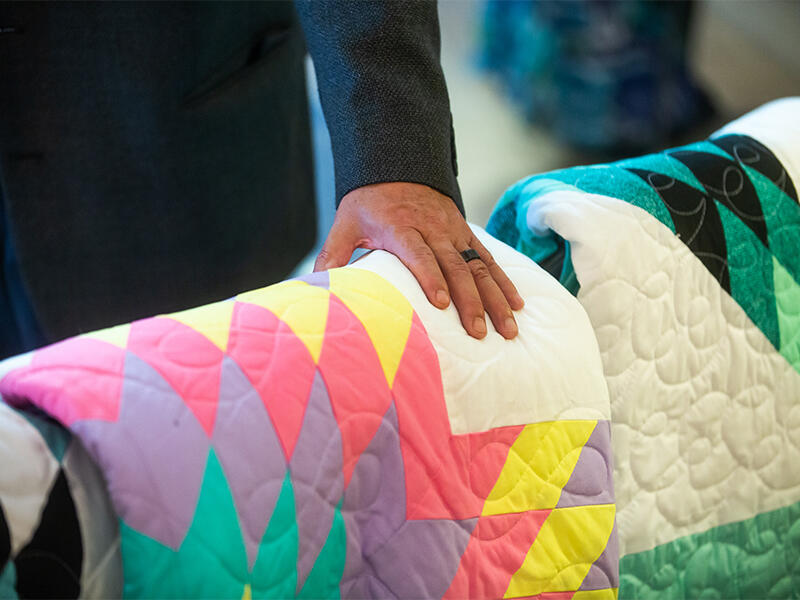Along with yearly celebrations, part of honoring Native American culture at Sanford Health is making sure the community has access to quality health care.
Just ask Scott Davis, a member of the Standing Rock Sioux Tribe and a descendent of the Turtle Mountain Band of Chippewa. He’s the head of Native American community outreach at Sanford Health in Bismarck, North Dakota.
He’s been in that role for six months, responsible for communicating health care needs both to the Native American community and to providers at Sanford Health.
Improving health care access: Native American Community Outreach at Sanford Health
Beyond his role at Sanford, he’s represented Native American heritage and culture for years.
“I’ve served at the governor’s office as the Indian affairs commissioner for 12 years. Three governors, and 23 tribal chairs. Obviously, my portfolio and my network covered a lot of health care during that time,” he explained.
The need for quality health care
In that time, he’s seen the health care challenges Native Americans face, and experienced it himself.
“I’ll use myself for (an) example. I have heart disease. It’s genetic. I’m 52 years old, and never in my wildest dreams I thought I would ever have heart disease. I grew up knowing statistics about Native American men, in particular, life expectancy was anywhere from 52 to 55. Growing up, I thought, ‘I’m going to smoke that.’
“Lo and behold, when I turned 50, I told my doctor I’d like to check my heart, just to make sure. My father went through heart disease. My uncle died from it. It’s really prevalent. So, here I am with it, and I had a heart attack last year at the age of 51. (And) had open heart surgery, bypass surgery, and I thought I was living a pretty healthy life,” he said.
He said his story is “just one example” of the health disparities Native Americans face. Diabetes and cancer are also prevalent.
“Now, with COVID, our mortality rate is four times higher than the average American, or North or South Dakotan, (or) Minnesotan. Why is that?” he said.
Ultimately, if you ask Davis, it boils down to a lack of health care.
“As tribal people, tribal leaders, we will always go back to treaty obligations. Back in those days, our tribal leaders drew treaties, the law of the land, and in the agreement of taking our land, they would have to provide health care services as one of them.
“That’s been a challenge for tribal leaders to really keep the foot on the pedal. Trying to keep Congress and the Indian Health Services accountable for that treaty. Twenty-five years ago, I started paying attention to this as a young man working for my tribe. Quite honestly, nothing has changed as far as statistics go. We’re still number one in a lot of those categories,” Davis said.
A change in mindset
So, what could help? If you ask Davis, it’s a shift in how health care is viewed.
And he’s eager to get started.
“How can we look at health care in a different light? When it comes to community health, public health, environmental health, and even our own self. That’s the challenge here that I’m really looking forward to. Working with an enterprise like Sanford, we have resources. That’s what really, really attracted me to come on board here. We have resources,” he said.
Davis will act as the liaison between tribes and Sanford Health. As he’s done more digging, he’s realized just how much Sanford Health can pioneer better health care to Native American communities.
“I have kind of been peeling back the onion of these resources, and wow. We do have resources here. Sanford is very excited to partner with tribes, if tribes want to partner on certain things. Let’s change the mindset of how we can provide better care. Not just when they’re in Bismarck, Fargo, Sioux Falls, or Bemidji, but back home,” Davis said.
“More importantly to me than anything else, is how can we bring better services to our tribal people back home?” he added.
Moving forward
The first step is ongoing dialogue. And education.
“(It’s) expressing the identity of who we are in a respectful way, through an educational format too. I think we all agree that there has been some really bad press. Some really, really terrible history written about us that we’re always the boogeyman,” he said.
In fact, it’s quite the opposite, Davis explained.
“We are a very, very peaceful people. What does the word ‘Dakota’ mean? That’s common sense to us. It means friend. It means ally. It means peace,” he said.
Davis said with 10% of Sanford’s patients being Native American, it’s significant that Sanford Health has placed an importance on Native American representation at leadership levels.
Learn more
- Sanford works to provide culturally competent care for all
- Health advocate provides comfort, trust for Native patients
- Sanford Health supports, celebrates Native American cultures
…
Posted In Bemidji, Bismarck, Community, Fargo, Here for all. Here for good., Inclusion at Sanford, Leadership in Health Care, People & Culture, Sioux Falls

